British Columbia
| |
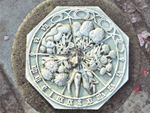 |
Vancouver |
British Columbia |
Canada |
Horizontal Dial |
Dial 932 |
| This was once a very beautiful sundial sitting on a short concrete pedestal. Now it has a missing gnomon and the dial color is uniformly aquamarine except where the coating has been rubbed away to reveal a white substrate. Tapping the dial face makes a dull sound suggesting the dial is not metal and may be hollow. A possible explanation is that the dial could be made of some kind of cast resin or fiberglass and was then spray-painted. The dial face itself is elegantly sculpted into five sectors, showing clusters of flowers, berries and fruits, creating a pronounced 3D effect. Because of this, the hour lines are reduced to short ticks at the edge of the dial face. The dial shows solar hours, marked off using Roman numerals. |
| |
| |
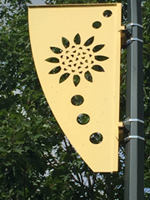 |
Vancouver |
British Columbia |
Canada |
Sculpture/Artwork |
Dial 990 |
| This artwork along Prince Edward street stretches about 1.5 mile (2.4 km). The latitude and longitude are given for the mid point. As public art the installation is know as Solar Patterns I and II. They are a collection of metal banners attached high on street poles and at eye level, an explanation of the pattern in the banner. Each banner consists of a yellow or orange aluminum sheet perforated with round holes representing the sun following a simple curve that is part of the analemma. The third dot from the top of the banner is replaced by an image of the sun as conceived by various artists ranging from school children to iconic images from various cultures to historic representations of the sun from cave paintings. |
| |
| |
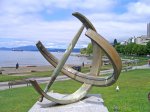 |
Vancouver |
British Columbia |
Canada |
Equatorial Dial |
Dial 645 |
| A 30 inch diameter bronze equatorial dial. A slot in the rotatable gnomon project a line of sunlight onto the equatorial ring displaying Arabic hour numerals. Dial is corrected for longitude. Dial is mounted on a 53 inch high stone pedestal. This dial is also known as the George Cunningham Memorial Sundial as it was sponsored by the Cunningham Drug Stores to commemorate the opening of their first store in 1911 at a nearby corner. |
| |
| |
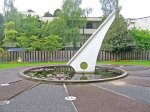 |
Vancouver |
British Columbia |
Canada |
Horizontal Dial |
Dial 648 |
| A large concrete and pebble horizontal dial with a 30 foot high gnomon. Hour lines are wood dividers in concrete with Roman numeral hour markers. Dial center and gnomon are situated in a lily pond.
Dial is on private property but is fully visible from public street. |
| |
| |
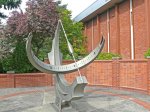 |
Vancouver |
Washington |
USA |
Equatorial Dial |
Dial 659 |
| A 2 meter diameter ring equatorial dial of welded anodized aluminum plate. The dial face shows Arabic numerals with hour and quarter-hour marks. This face can be moved for longitude correction and DST, and was originally adjusted to correct periodically for EOT. In 2009, the original straight gnomon was replaced with an analemmic gnomon, eliminating the need to adjust or correct for EOT. |
| |
| |
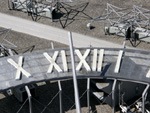 |
Vancouver |
British Columbia |
Canada |
Horizontal Dial |
Dial 1099 |
| This is intended to be a horizontal sundial, but positioned poorly and viewed by nearly no one.. The chapter ring is marked out in Roman numerals running from V (am) to IV (pm) on a large semi-circular arc of open metalwork supported by a trellis structure. It is very large, about 40 meters across. The gnomon is a separate structure and is not positioned or oriented correctly. |
| |
| |
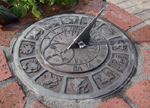 |
Ventura |
California |
USA |
Horizontal Dial |
Dial 1007 |
| The central part of the bronze sundial, approximately 12 inches in diameter, has the traditional hour marks and divisions into 15 minute intervals and surrounded by Roman numerals from 5am to 7pm. South of the gnomon is a simple compass rose with four cardinal points. With the dial at ground level the gnomon has led a hard life and is now held to the dial plate with improvised brackets. Surrounding the dial, doubling the size to 24 inches in diameter is an elegantly engraved ring of the twelve figures of the zodiac, each named on the outer ring with the corresponding month on the inner ring. |
| |
| |
 |
Vernon |
British Columbia |
Canada |
Analemmatic Dial |
Dial 933 |
| This is a standard outdoor analemmatic dial located on a hillside allowing all-day illumination and providing good views of Vernon and the surrounding area. The layout was designed by James Kanester. Rather than acting as a "Human Sundial" this analemmatic uses a movable vertical pole that sits in a slot in the declination scale. A central figure-8 analemma curve provides an indication by date where to place the gnomon in the slotted meridian grove. The declination scale, designed and constructed by Joel Wrinch, is wooden with engraved lettering and analemma. The dial's hour marks are concrete posts, topped by glass mosaics made by local artist Connie Vetter-Johnson. Only whole hours are marked. Dial furniture includes a larger glass mosaic image of a hawk. The dial's major axis is about 22 feet, the declination scale is about 6 feet long, the hour markers are 12 inches in diameter. The hawk mosaic is about 18 inches in diameter. |
| |
| |
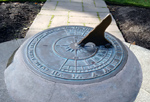 |
Victoria |
British Columbia |
Canada |
Horizontal Dial |
Dial 924 |
| A standard cast bronze sundial, 12 inches in diameter. It shows solar time with Roman numerals from V to VII with noon as XII. Also marked are the half and quarter hours. The hour lines and gnomon angle are correct for the latitude. The gnomon root is in the center of the circular casting in the center of the wind rose showing the cardinal directions. |
| |
| |
 |
Victoria |
British Columbia |
Canada |
Horizontal Dial |
Dial 1046 |
| An ordinary mass-produced horizontal dial mounted on a simply decorated cast concrete pedestal. 11.5" diameter, cast iron with verdigris finish. The dial face is inclined but in the wrong direction, opposite to what is needed to properly align the style to the polar axis (cannot be corrected because fixture is damaged). Appears to be a Model #2550 'Father Time' dial from Rome Industries. |
| |
| |
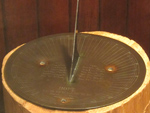 |
Victoria |
British Columbia |
Canada |
Horizontal Dial |
Dial 813 |
| This brass horizontal sundial was designed and engraved for use in the town of Hope BC by British Royal Engineers in 1860. The circular dial is 8 inches diameter with a triangular gnomon. Time lines are engraved at 15 minute intervals from 4 am to 8 pm. The dial is on display in the museum beside other survey instruments and the red uniform of a Royal Engineers Sergeant. |
| |
| |
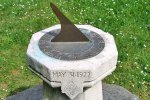 |
Victoria |
British Columbia |
Canada |
Horizontal Dial |
Dial 572 |
| A replica 12-inch bronze horizontal dial on a concrete plinth. This dial is a memorial for Marjorie Napier, a twelve-year-old St. Ann's student who died on 31 May, 1922. The original dial and limestone plinth were moved to Queenswood, a private retirement home for elderly nuns and seniors. A plaque for the replica dial reads, "In memory of Una Holm (Robertson) Class of 1928. Thank you the Sisters of St Ann's, the strength of Sister Eleanor Marie and the Rock which was St Ann's Academy. Replica sundial donated by husband Sandy E S A Holm and their daughter Karen Michaelson (Holm) Class of '53." |
| |
| |
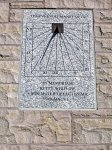 |
Victoria |
British Columbia |
Canada |
Vertical Dial |
Dial 575 |
| A 30x20-inch vertical dial declining 7° 33' west of south made of granite inset in a stone wall. A memorial dial for Betty Whitlow commissioned by Dean Brian Whitlow. Inscribed, "IN MEMORIAM BETTY WHITLOW, UXOR MATER DELICTISIMUA, MCMXCVI." Information on EOT and longitude corrections are available just inside the south door of the cathedral. |
| |
| |
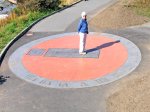 |
Victoria |
British Columbia |
Canada |
Analemmatic Dial |
Dial 663 |
| A 20 foot overall tinted concrete analemmatic dial with brass numerals, aluminum and granite slabs. Distance between major axis and small hour marks is 16.4 feet. Brass Roman numerals 10 inches high are set in a grey outer ring. Longitude and EOT corrections are marked beside the monthly date marks. A plaque commemorating the British Columbia 150 year celebration includes instructions on use and information on the dial designers and sponsors. |
| |
| |
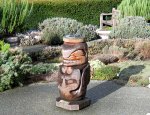 |
Victoria |
British Columbia |
Canada |
Horizontal Dial |
Dial 752 |
| A bronze horizontal dial with hour lines, quarter-hour marks and Roman hour numerals. Dial face includes a central compass rose. The dial sits atop a carved cedar totem depicting an Orca killer whale. The totem is carved in the Coastal Salish tradition by Aubrey LaFortune, a member of the Cowichan Band of native Canadians. |
| |
| |
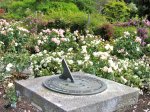 |
Victoria |
British Columbia |
Canada |
Horizontal Dial |
Dial 753 |
| A 12 inch diameter cast bronze horizontal dial with hour lines, quarter-hour marks and Roman hour numerals. Dial face includes a central compass rose with cardinal directions. The dial sits atop a cast concrete pedestal sculptured with curves, fronds and cherubs. However the dial may be misaligned from true North. The gnomon angle appears close to the dial's latitude (measured at 49.2°). |
| |
| |
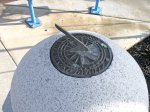 |
Victoria |
British Columbia |
Canada |
Horizontal Dial |
Dial 754 |
| A 9 inch diameter cast bronze dial with hour and half-hour marks and Roman hour numerals. The dial face has a compass rose at the center with cardinal and ordinal directions. The casting is of poor quality and the gnomon, brazed in place, is bent and at the wrong angle.
The sundial is a monument to the Point Hope Shipyard. Engraved on one side is the history of the shipyard, the oldest in British Columbia, renovated and reopened in 2007. The cast dial pedestal is marked, "This newel post was saved from the demolition of St. Mary's Hospital, Victoria. |
| |
| |
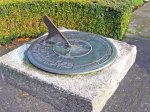 |
Victoria |
British Columbia |
Canada |
Horizontal Dial |
Dial 755 |
| A 12 inch diameter cast bronze horizontal dial with hour lines, quarter-hour marks and Roman hour numerals. Dial face includes a central compass rose with cardinal directions. The dial sits atop a cast decorative concrete pedestal. The dial is correctly designed for the location and is one of at least seven such dials in the Victoria area. |
| |
| |
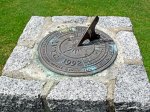 |
Victoria |
British Columbia |
Canada |
Horizontal Dial |
Dial 756 |
| A 12 inch diameter cast bronze horizontal dial with hour lines, quarter-hour marks and Roman hour numerals. Dial face includes a central compass rose with cardinal directions; large characters inscribe RVYC and 1992. Dial sits atop a tapered mortared stone pedestal |
| |
| |
 |
Villahermosa |
Tabasco |
Mexico |
Compound Dial |
Dial 380 |
| A "Gnomonicon", or multi-indication dial, made of concrete, aluminum, brass and copper. The dial stands approximately 5 feet high and has multiple solar time dials in many orientations plus a flat equatorial, a concave equatorial, a revolving equatorial and a rare spherical dial. Also a solar calendar and representations of the ecliptic and the zodiac. |
| |
| |
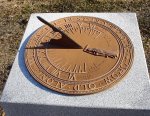 |
Vincennes |
Indiana |
USA |
Horizontal Dial |
Dial 687 |
| a 14 inch diameter cast metal horizontal dial with 15 minute hour lines and Roman hour numerals. Sunrise and sunset times at solstices marked by additional lines. Dial face includes grim reaper figure. Hour lines and gnomon may be designed for different latitude; this may be a commercial dial but it is clever and unrecognized if so. Dial sits on a square tapered marble pedestal with stepped square bases. |
| |
| |
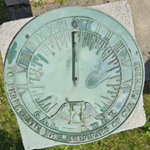 |
Wabash |
Indiana |
USA |
Horizontal Dial |
Dial 1125 |
| This horizontal bronze dial is approximately 12 inches (30cm) in diameter with a heavy green patina. The gnomon long ago was broken off. The inner chapter ring shows local solar time in half hour increments marked in Roman numerals from 6am to 6pm. The dial is decorated by an hour glass. The dial sets on a square 12x12 in (30x30cm) plinth. The pedestal is a column 4 in (10cm) in diameter and approximately 36in (91cm) tall with the top half fluted. |
| |
| |
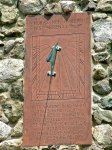 |
Waltham |
Massachusetts |
USA |
Vertical Dial |
Dial 191 |
| A declining vertical sandstone dial approximately 3x6 feet with bronze gnomon. Mounted at 2nd floor level on large stone house. Roman numerals. Hour lines from 6 am-5 pm are not in standard vertical position, presumably offset to correct for wall not facing due South. Dial reclines approx 2 degrees north. Dial # 190 (Cambridge MA, Mt. Aubry Cemetery, Story Chapel) has same Whittier inscription. |
| |
| |
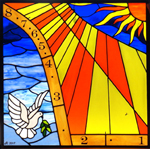 |
Waring |
Texas |
USA |
Vertical Dial |
Dial 870 |
| This is a rare American stained glass sundial, accurately telling time and season. It occupies the center panel of a five panel window that forms a cross. The vertical sundial panel measures 28x28 inches and declines 48° west of south, so it only functions in the afternoons. The dial is longitude corrected and indicates Daylight Saving Time when readings are adjusted using the Equation of Time. The gnomon is a 3/4 inch brass ball nodus attached by a non-polar axis rod to the aluminum Sussman window frame. It is the only stained glass sundial in the world that uses frosted colored stained glass to enhance the view of the nodus shadow. It has three seasonal date lines, a solar noon mark, and other marks showing special anniversary dates. It contains the traditional fly, seen on the the lower yellow panel between 1pm and 1:30pm. |
| |
| |
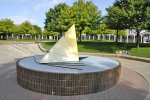 |
Warren |
Michigan |
USA |
Horizontal Dial |
Dial 269 |
| Horizontal dial 16 ft in diameter with 6 ft gnomon. The Sundial is pyramid shaped, painted in four different shades of yellow and white. Two sighting tubes along slanted upper edge. Sundial sits in center of circular concrete base with brick facing. |
| |
| |
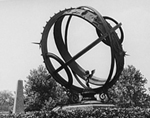 |
Washington |
District of Columbia |
United States |
Armillary Sphere |
Dial 284 |
| The original Noyes armillary sphere was donated by Bertha Noyes in honor of her sister, Edith. Made of copper and bronze, the 6-foot armillary had an equatorial band with symbols of the zodiac, a meridian circle and arctic & antarctic circles. A winged cherub — a putto — stood in the center. The dial sat upon a octagonal polished green granite base. |
| |
| |
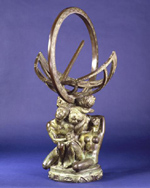 |
Washington |
District of Columbia |
USA |
Equatorial Dial |
Dial 297 |
| Bronze 36 in. sundial titled "Garden of Eden". Smithsonian notes: "In Garden of Eden Sundial, the long stick would indicate the time by casting a shadow on the numbers that line the inside of the sphere. Marie Louise Speed commissioned this depiction of the Garden of Eden to decorate private grounds surrounding her estate outside Louisville, Kentucky. In the scene, Adam and Eve grasp the fruit of knowledge that will drive them from paradise. Manship patterned Adam’s hair on the serpent’s scales to emphasize man’s fall from grace." |
| |
| |
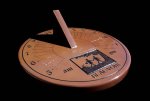 |
Washington |
District of Columbia |
USA |
Horizontal Dial |
Dial 316 |
| A horizontal dial 26 inches in diameter with a 9 inch gnomon. Has hour and half hour lines from 5 am to 7pm with 10 minute marks. Made of chocolate sandstone. South of the gnomon is an engraving of two children walking under a tree. Designed by John Carmichael |
| |
| |
|
Washington |
District of Columbia |
USA |
Gnomonic or Projection Dial |
Dial 491 |
| With a bit of whimsy at the end of each day for over two years, Dr. James Griffith marked the position of a ray of sunlight on a wall that entered from a west window overlooking the Potomac river. The result is an analemma, tracing the sun's position at 4:10 pm E.S.T. throughout the seasons. Dr. Griffith was a chemist, but as written on a plaque next to the analemma, "Exactly what this has to do with chemistry per se is not perfectly clear, but Viva Principia Scientifica!" |
| |
| |
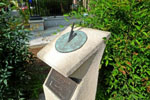 |
Washington |
DC |
USA |
Horizontal Dial |
Dial 793 |
| An incorrectly installed but prominently displayed 8 inch bronze horizontal dial with hour, half-hour and quarter-hour lines and Roman hour numerals from 5 AM to 7 PM. The bronze gnomon is inclined from the dial face approximately 42° and the hour lines appear correct for that latitude, though the local latitude is about 39°. |
| |
| |
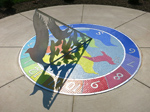 |
Washington |
District of Columbia |
USA |
Horizontal Dial |
Dial 850 |
| This horizontal dial was commissioned by the District of Columbia Department of General Services for the newly renovated River Terrace Educational Campus. The mosaic dial is installed within a 20 ft diameter concrete plaza. The dial face is a beautifully colored spectrum of Italian Piccolo porcelain 1-inch mosaic tiles encompassing a circle 8 ft in diameter. Embedded in the mosaic chapter ring are 7-inch aluminum Arabic numbers marking the hours from 6am to 6pm and just within are letters marking the cardinal points. The aluminum gnomon is 4 ft. long and 2.83 ft tall. |
| |
| |
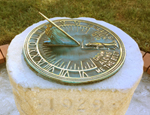 |
Washington |
District of Columbia |
USA |
Horizontal Dial |
Dial 880 |
| This simple bronze sundial about 12 inches in diameter sits on a 3-foot fluted plinth made from Indiana limestone. Embossed hour lines extend from 5am to 7pm delineated every 15 minutes. Surrounding the hour chapter are Roman numerals with the noon hour marked by "0". The gnomon is very attractive, with a bird ensconced between the style and base. The dial was given to Howard University by the Lampados Club of Alpha Chapter, Omega Psi Phi Fraternity in 1929 to honor Benjamin Banneker, 18th century astronomer, surveyor and executing architect of the District of Columbia. |
| |
| |
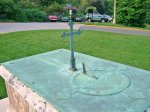 |
Washington |
District of Columbia |
USA |
Horizontal Dial |
Dial 34 |
| A cathedral landmark. 6 foot rectangular crypt with a 2 foot circular horizontal dial in bronze. Adjoining the dial is a cross noon marker that casts its shadow onto the crypt with major Christian holidays marked through the year. Gnomon has a folded shape of 2 cm width but the hour lines form only one dial center although the space at noon gap is 1 cm. |
| |
| |
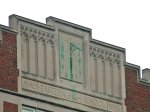 |
Washington |
District of Columbia |
USA |
Vertical Dial |
Dial 202 |
| Vertical dial with bronze Roman numerals and trefoil pierced gnomon on square sandstone. Dial is on south facade over main entry, facing East Capitol Street. School is dated 1923 and architect Snowden Ashford. Elevation above entrance is approximately 30 ft. making dial hard to read. Large projecting towers place dial in shadow in early morning and late afternoon. Similar to McKinley High School dial (#207). |
| |
| |
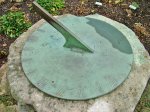 |
Washington |
District of Columbia |
USA |
Horizontal Dial |
Dial 203 |
| In the Bishop's garden is a weathered 13th C. capital on which sits a 41 cm diameter horizontal brass dial. It is engraved with "Tho Heath, London" and the year 1712. On the noon line is the indication "Hammersmith", a location on the (then) outskirts of London at 51:30N 0:14W. Heath is one of the Grocers' Company mathematical instrument makers Many of Heath's dials have a coat of arms. |
| |
| |
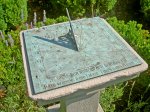 |
Washington |
District of Columbia |
USA |
Horizontal Dial |
Dial 204 |
| Horizontal dial about 16 inch square made of bronze. Gnomon is 4.125 inch high, 5 inch long. Below gnomon is motto, "Horas non numero nisi serenas" (I only count sunny hours). House was built in 1805 and is now open to the public as a museum. Years before this property was opened to the public, a family member brought this dial from Crossbasket Castle in Scotland, the family seat. The lengthy inscription is probably a later addition, since it is unlikely that they would be quoting Whittier in Scotland. The gnomon angle is 39? 30', probably made for the Washington DC location. However, the dial plate has a latitude of about 48? N, certainly not Scotland. What is the true origin of this dial? |
| |
| |
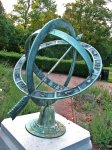 |
Washington |
District of Columbia |
USA |
Armillary Sphere |
Dial 205 |
| Very nicely armillary sphere about 3 ft. diameter, with equatorial, meridional and hour circles. Roman hour numerals from 5 AM to 7 PM. One of Washington DC's cleanest examples of a working armillary sphere. Erected by the Georgetown Garden Club in 1956 in tribute to Sarah Louisa Rittenhouse. Dial is placed atop a sandstone pillar. |
| |
| |
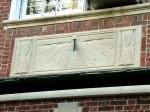 |
Washington |
District of Columbia |
USA |
Vertical Dial |
Dial 206 |
| Sandstone Vertical declining dial, with gnomon offset to account for it. Above doors to rear terrace of admissions building. Arabic hour numerals with half hour lines. Carved hourglasses on both sides frame the dial. Brass compass rose set into the brick terrace below suggests the general alignment of both house and dial. |
| |
| |
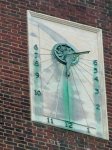 |
Washington |
District of Columbia |
USA |
Vertical Dial |
Dial 207 |
| Vertical bronze dial with Arabic numerals and long cast sunburst gnomon. On oblong sandstone. Dial is 60-80 feet up on an octagonal power plant smokestack. It is difficult to read, but safe from vandalism. School dated 1928. Similar to Eastern High School (#202). |
| |
| |
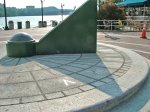 |
Washington |
District of Columbia |
USA |
Horizontal Dial |
Dial 208 |
| Large, ground level horizontal dial 16 ft. in diameter with 49 in high stepped hollow painted-green metal gnomon that is 5 ft 16 in long. Roman hour numerals with hour lines from 4:30 AM to 9:30 PM. Gnomon structure recalls the much larger Indian observatory dials. An appropriate poetic passage, once bolted to the gnomon, has disappeared. |
| |
| |
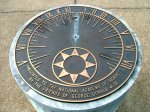 |
Washington |
District of Columbia |
USA |
Horizontal Dial |
Dial 210 |
| Circular horizontal dial 20 in. diameter cast in bronze. Has Roman numerals at hours and 15 minute marks. Gnomon missing from dial, but kept by groundskeeper, as it will not stay in place. Was temporarily re-installed for the NASS tour in 1995. The dial is modern, honoring George Donald Meid for service to the National Academy. Dial is mounted atop a concrerte cylindrical post. |
| |
| |
 |
Washington |
District of Columbia |
USA |
Horizontal Dial |
Dial 218 |
| Horizontal dial 12 in. square designed and built by David Shayt and David Todd of the Smithsonian Institution. Roman numerals, 5AM-7PM. Subdivided into 15 minute increments. Also has compass rose. Dial sits atop a rectangular granite pedestal. |
| |
| |
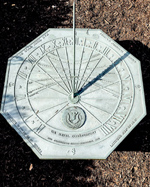 |
Washington |
District of Columbia |
USA |
Horizontal Dial |
Dial 256 |
| Octagonal bronze horizontal dial, mounted just above the ground level. Designed by Richard Schmidt of the USNO staff and cast by Alex Bigler of Equestrian Forge celebrates the 100th anniversary of the move of the USNO to its present site at Observatory Circle. The USNO was founded in 1830. Public, but by appointment only (202-762-1438). |
| |
| |
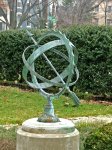 |
Washington |
District of Columbia |
USA |
Armillary Sphere |
Dial 257 |
| The bronze armillary sphere dial is unremarkable yet is oriented accurately and is complete. About 2 feet in diameter. Hour numerals are Roman and show 5 AM to 7PM. It commemorates a longtime gallery official. |
| |
| |
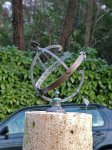 |
Washington |
District of Columbia |
USA |
Armillary Sphere |
Dial 588 |
| A 20 inch diameter bronze armillary on a four foot pedestal. Roman hour numerals from 3 AM to 9 PM. |
| |
| |
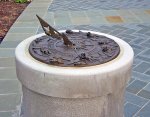 |
Washington |
DC |
USA |
Horizontal Dial |
Dial 644 |
| A bronze horizontal dial about 18 inches diameter on a cast concrete pedestal. Perimeter of dial includes three-dimensional cast replicas of roses and butterflies. Bronze gnomon includes replicas of butterfly, tightly-furled rose and leaf. Dial face has hour lines with Roman numerals and 15-minute marks and a sunburst at dial center. The dial rests on a cast concrete pedestal. |
| |
| |
|
Washington Crossing |
New Jersey |
USA |
Horizontal Dial |
Dial 164 |
| A 13-inch diameter horizontal dial made of iron. The dial has hour lines from 5am to 7pm, marked with Roman numerals. The gnomon is of unusual design. Set at 45 degrees, the style is supported by the profile of an eagle, head facing northward, and tail tapering to the southern point of the style. The base is a square pedestal, cobbled of stone and mortar. At top is a stone cut square to hold the dial. |
| |
| |
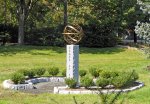 |
Waterbury |
Connecticut |
USA |
Armillary Sphere |
Dial 757 |
| A 24 inch diameter armillary with meridian, horizon, equatorial, tropic, Arctic and Antarctic rings. Equatorial ring is engraved with Roman hour numerals. The dial is supported on a narrow 4 foot tall granite pedestal.
The pedestal includes a plaque with an EOT graph and is inscribed to indicate the dial is the Class Gift of 2010. |
| |
| |
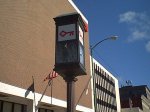 |
Watertown |
New York |
USA |
Vertical Dial |
Dial 442 |
| The vertical dial is on one face of a ornamental rectangular display raised on pole at the edge of the street at Key Bank Clock Plaza. The dial is approximately 2-foot square with an ornate gnomon having a "key" cutout. The dial was moved from another location to the present pole and restored. The dial is made of copper or bronze. Nearby is a plaque with the equation of
time. Dedicated May 15, 1967. |
| |
| |
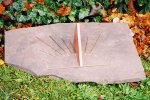 |
Watkins Glen |
New York |
USA |
Horizontal Dial |
Dial 517 |
| A simple horizontal dial made of slate with a copper gnomon. Hour lines are brass rods artfully arranged from 6am to 6pm. The hour lines are corrected for longitude. |
| |